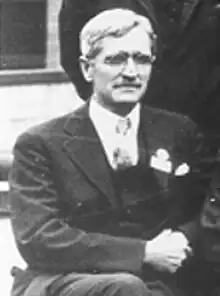Frederick Albert Saunders
Frederick Albert Saunders (August 18, 1875 – June 9, 1963) was a Canadian-born American physicist and academic remembered for his work in sub-infrared spectroscopy and acoustics.
Frederick Albert Saunders | |
|---|---|
 Saunders at Bell in 1928 | |
| Born | August 18, 1875 London, Ontario, Canada |
| Died | June 9, 1963 (aged 87) |
| Academic background | |
| Alma mater | |
| Doctoral advisor | Henry A. Rowland |
| Academic work | |
| Discipline | Physics |
| Institutions |
|
Early life
Frederick Albert Saunders was born on August 18, 1875, in London, Ontario, a son of William Saunders and Sarah Agnes Saunders, née Robinson, both of whom were born in England and emigrated to Canada at an early age.[1][2] His father was renowned in the fields of orchard pests and fruit hybridization, was a founding member of the Entomological Society of Ontario and published books including Insects Injurious to Fruits (1883, J. B. Lippincott & Co.) and numerous scientific papers. He was recognized with honorary degrees from several universities and by honours from King George VI.[2]
Saunders graduated with a Bachelor of Arts from the University of Toronto in 1895.[3] Saunders studied physics at Johns Hopkins University and worked under Henry A. Rowland, a pioneer in use of diffraction gratings for spectroscopy, graduating PhD in 1899.[3]
Career
He tutored in physics at Haverford College from 1899 to 1901, then at Syracuse University, where he reached the status of professor in 1914.[2][3] At Syracuse he worked with Alfred Fowler studying spectra in the far infra-red region, and during his sabbatical year 1913–14 worked with Friedrich Paschen at the University of Tübingen. Shortly after his return to America in 1914, he took a teaching position at Vassar College, and during World War I worked with Augustus Trowbridge (1870–1934), Karl Taylor Compton and Henry Norris Russell, developing methods of sound ranging. With Russell he would later develop Russell–Saunders coupling. In 1918 he worked as spectroscopist under R. A. Millikan at the National Research Council in Washington, D.C., followed by a short stint at the General Electric Research Laboratory in Schenectady, New York, as the guest of Willis Whitney, from 1917 to 1919.[2][3]
After a brief return to Vassar, he was invited to Harvard University by Theodore Lyman to continue his spectrographic work, then was appointed by that institution to take over the fundamentals course from the recently deceased Wallace C. Sabine, and held that position for 22 years. His textbook, A Survey of Physics for College Students, initially given a lukewarm reception by students,[4] went through several editions.[2] He was a professor at Harvard from 1919 to 1963.[3] He was a visiting lecturer at Mount Holyoke College from 1942 to 1948.[3]
Frederick Albert Saunders is one of the founders of the Acoustical Society of America (ASA)[5]. with other renowned acousticians, at the Bell headquarters in New York City, on December 27th, 1928[6].
Death
Saunders died on June 9, 1963, at his home in South Hadley, Massachusetts.[1][3][7]
References
- "Noted Physicist Dies". Idaho Statesman. June 10, 1963. p. 13. Retrieved June 7, 2021 – via Newspapers.com.
- Harry F. Olson (1967). "Frederick Albert Saunders" (PDF). National Academy of Sciences. Retrieved October 29, 2019.
- "FREDERICK A. SAUNDERS". American Institute of Physics. Retrieved June 7, 2021.
- unknown. "Prof Saunders Writes Textbook". The Harvard Crimson. Retrieved October 30, 2019.
- History of the ASA https://asahistory.org/history-of-the-asa/
- News Notes. The Acoustical Society of America was formed at a meeting held here on December 27 (page 253) https://worldradiohistory.com/Archive-Bell-Laboratories-Record/20s/Bell-Laboratories-Record-1929-Feb.pdf
- "Dr. Frederick A. Saunders". The Chicago Tribune. June 10, 1963. p. 58. Retrieved June 7, 2021 – via Newspapers.com.
External links
 Media related to Frederick Albert Saunders at Wikimedia Commons
Media related to Frederick Albert Saunders at Wikimedia Commons